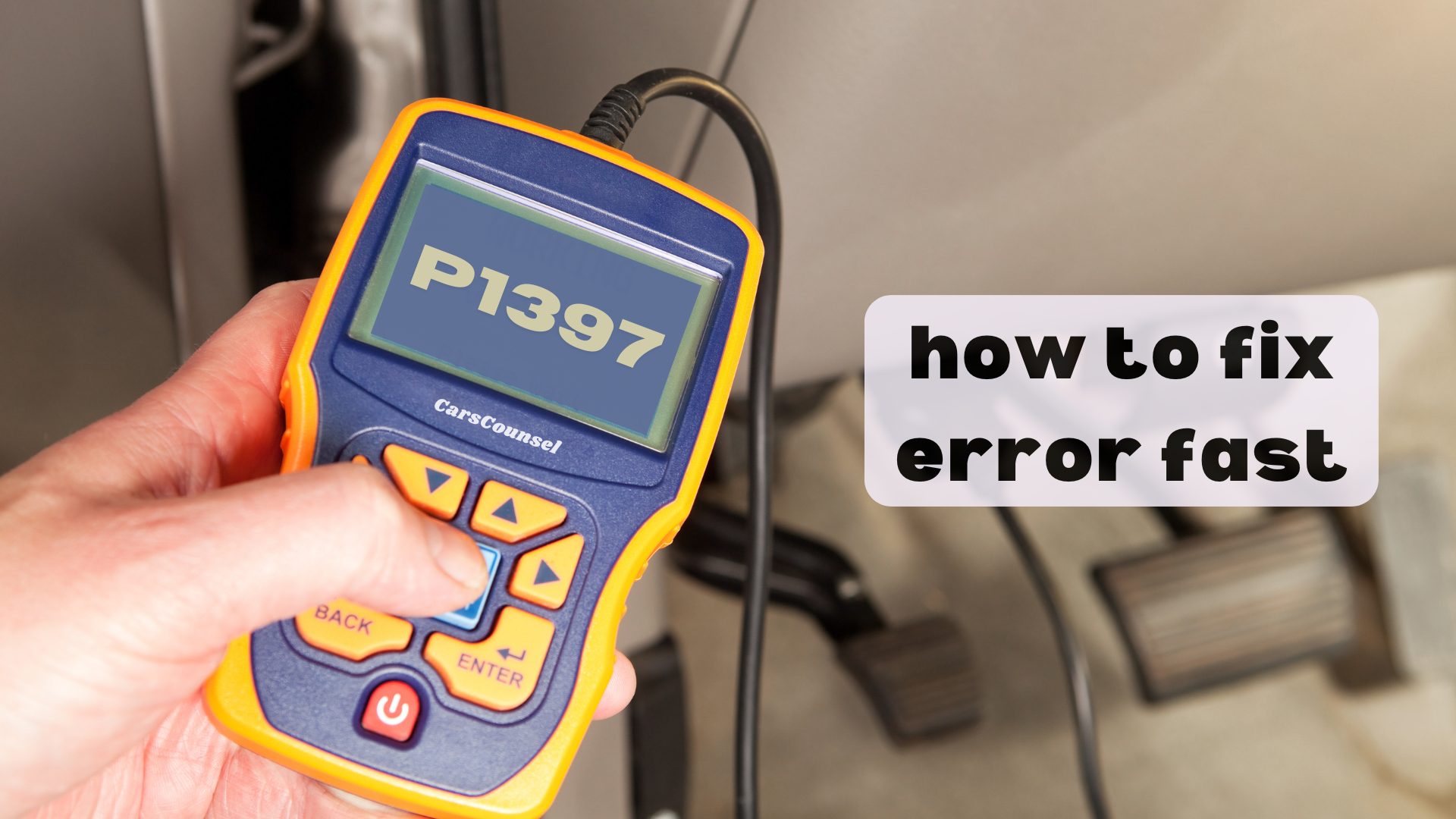As you turn the key, your vehicle’s engine sputters to life, but something’s amiss – the dashboard lights are dim, and the radio’s struggling to find a signal. You’ve got a problem on your hands, and the P1397 code is the culprit, warning you that your system voltage has strayed out of the self-test range.
This is more than just a minor glitch; it’s a red flag that your vehicle’s electrical components are at risk. What’s causing this malfunction, and how can you get your ride back to its usual self?

Quick Navigation
Key Takeaways
- The P1397 code indicates system voltage has strayed out of the self-test range, causing electrical components to malfunction or operate below peak levels.
- Faulty voltage regulators, alternator malfunctions, and corroded or loose battery terminals are common causes of the P1397 code.
- Symptoms include dim or flickering headlights, slow engine crank, difficulty starting the vehicle, and electrical accessories malfunctioning or not functioning at all.
- Ignoring the issue can lead to further electrical component damage, and prompt attention is necessary to prevent total system failure.
- A professional technician should diagnose and repair the underlying cause to guarantee the vehicle’s electrical system operates within recommended parameters.
Code Description and Meaning
When your vehicle’s onboard computer triggers the P1397 code, it’s a red flag indicating that the system voltage has strayed out of the self-test range.
This means voltage fluctuations in your vehicle’s electrical system aren’t within the manufacturer’s expected parameters. As a result, electrical components may malfunction or operate below peak levels.
Voltage fluctuations can be caused by electrical surges or other issues, leading to problems with starting the vehicle, poor fuel efficiency, rough idling, or stalling.
It’s essential to address this issue to prevent potential damage to other electrical components over time.
Understanding the fault code description and meaning is vital to diagnose and repair the problem efficiently.
Common Causes and Symptoms
Faulty voltage regulators, alternator malfunctions, and corroded or loose battery terminals are common culprits behind the P1397 code.
These issues can cause voltage fluctuations, leading to electrical surges that disrupt the vehicle’s electrical system. As a result, you may notice symptoms such as dim or flickering headlights, slow engine crank, or difficulty starting the vehicle.
Additionally, you might experience electrical accessories malfunctioning or not functioning at all. In some cases, you may even notice a burning smell or see sparks coming from the alternator or battery.
It’s essential to address these issues promptly to prevent further damage to your vehicle’s electrical components.
Effects on Vehicle Performance
The P1397 code can significantly impact your vehicle’s overall performance, causing a range of issues that affect its reliability and functionality.
Voltage fluctuations and electrical surges can lead to malfunctions in critical systems, such as the engine, transmission, and electrical accessories. You may experience issues with starting the vehicle, poor fuel efficiency, rough idling, or even stalling.
Additionally, the code can cause your vehicle’s onboard computer to miscalculate fuel injection, ignition timing, and other essential functions. This can result in decreased performance, reduced fuel efficiency, and potentially even engine damage if left unaddressed.
It’s essential to address the P1397 code promptly to prevent further damage and maintain your vehicle’s overall performance.
Diagnosis and Repair Costs
You’ll need to have your vehicle’s electrical system checked by a professional technician to diagnose the underlying cause of the P1397 code.
They’ll use specialized equipment to identify voltage fluctuations or electrical surges that may be causing the system voltage to fall outside the self-test range. The diagnosis process typically takes around an hour, depending on the complexity of the issue.
Repair costs can vary widely, ranging from $100 to $500, depending on the underlying cause and the necessary repairs. The technician will provide a more accurate estimate based on their findings.
Keep in mind that ignoring the issue can lead to further electrical component damage, so it’s essential to address the problem promptly.
Troubleshooting Steps to Follow
Frequently, when dealing with a P1397 code, it’s essential to follow a structured approach to troubleshoot the issue efficiently. This will help you identify the root cause of the problem and prevent misdiagnosis.
| Troubleshooting Step | Description | Potential Cause |
|---|---|---|
| Check battery voltage | Verify the battery voltage is within the recommended range | Voltage fluctuation |
| Inspect electrical connections | Look for signs of wear, corrosion, or damage | Electrical surge |
| Scan for other trouble codes | Check if other codes are present that may be related to the P1397 code | Multiple electrical issues |
| Check the alternator output | Certify the alternator is functioning correctly and providing the correct voltage | Alternator malfunction |
| Consult a wiring diagram | Verify the wiring is correct and not damaged | Wiring issue |
How to Fix the P1397 Code
About 80% of P1397 code issues can be resolved by addressing underlying electrical system problems.
You’ll need to identify and fix any issues with your vehicle’s Voltage Regulator, as it’s responsible for maintaining the correct system voltage.
Check for signs of Electrical Surges, which can cause voltage fluctuations and trigger the P1397 code.
Inspect the electrical system for any short circuits, corrosion, or damaged wiring that may be contributing to the issue.
Replace any faulty components, and verify all connections are clean and secure.
Once you’ve addressed the underlying electrical system problems, clear the code and test the system to confirm the voltage levels are within the expected range.
Preventing Future Occurrences
Preventing future occurrences of the P1397 code requires regular maintenance and monitoring of your vehicle’s electrical system.
You can avoid voltage-related issues by keeping a close eye on your battery’s condition and charging system performance. Regular voltage monitoring helps identify potential problems before they become major issues.
Make sure to check your battery’s state of charge, electrolyte levels, and charging system voltage regularly. Proper battery maintenance, such as cleaning terminals and ensuring secure connections, also goes a long way in preventing electrical system malfunctions.
Importance of Prompt Repair
Your vehicle’s system voltage is crucial to its overall performance, and ignoring the P1397 code can lead to further electrical system damage.
Voltage fluctuations can cause electrical components to malfunction, leading to issues with starting the vehicle, poor fuel efficiency, rough idling, or even stalling. If left unaddressed, the problem can potentially cause damage to other electrical components in the vehicle over time.
An electrical surge can also occur, which can lead to costly repairs or even a total system failure. It’s essential to address the P1397 code promptly to prevent these issues from escalating.
Don’t delay; consult a professional technician to diagnose and repair the underlying cause to guarantee your vehicle’s electrical system operates within the recommended parameters.
More OBD-II Codes
Frequently Asked Questions
Can a Faulty Battery Cause a P1397 Code to Appear?
You’re wondering if a faulty battery can trigger a P1397 code; the answer is yes, as a weak battery can cause voltage fluctuations, affecting your vehicle’s electrical system and resulting in a system voltage out of self-test range issue.
Will a P1397 Code Trigger the Check Engine Light?
You’re wondering if a P1397 code will trigger the check engine light. Yes, it’s likely, as voltage fluctuations and electrical surges can cause the light to come on, indicating a problem with your vehicle’s electrical system.
Can I Drive My Car With a P1397 Code Safely?
You’re 3 times more likely to experience electrical component failure driving with a faulty voltage monitoring system. In drive mode, restrictions apply: avoid extreme temperatures, heavy loads, and high-speed driving to minimize risks, but it’s still not recommended to drive your car safely with this code.
Is It Possible to Clear the P1397 Code Without Repairing the Issue?
You can’t simply clear the P1397 code without addressing the underlying issue, as voltage fluctuations and electrical surges will continue to affect your vehicle’s performance, potentially causing further damage if left unrepaired.
Will a P1397 Code Affect My Vehicle’s Warranty?
You should be aware that a system voltage issue may affect your vehicle’s warranty, potentially leading to warranty expiration if not addressed. It’s essential to schedule a vehicle inspection to diagnose and repair the problem to avoid any warranty implications.
Conclusion
You’ve finally diagnosed the pesky P1397 code, and now it’s time to take action. Remember, a malfunctioning electrical system can leave you stranded, with the average American driver spending around 290 hours per year behind the wheel – that’s equivalent to 12 days of driving in the dark, literally. Don’t let a faulty voltage regulator or corroded battery terminal turn your daily commute into a nightmare; get your vehicle’s electrical system back in check today.

